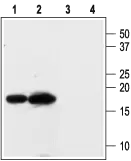
WB analysis of rat kidney (lanes 1 and 3) and heart (lanes 2 and 4) membrane lysates using GTX16690 KCNE3 antibody preincubated with or without immunogen peptide. Dilution : 1:200
KCNE3 antibody
GTX16690
ApplicationsImmunoFluorescence, Western Blot, ImmunoCytoChemistry, ImmunoHistoChemistry
Product group Antibodies
ReactivityHuman, Mouse, Rat
TargetKCNE3
Overview
- SupplierGeneTex
- Product NameKCNE3 antibody
- Delivery Days Customer7
- ApplicationsImmunoFluorescence, Western Blot, ImmunoCytoChemistry, ImmunoHistoChemistry
- CertificationResearch Use Only
- ClonalityPolyclonal
- Concentration0.8 mg/ml
- ConjugateUnconjugated
- Gene ID10008
- Target nameKCNE3
- Target descriptionpotassium voltage-gated channel subfamily E regulatory subunit 3
- Target synonymsBRGDA6; cardiac voltage-gated potassium channel accessory subunit; HOKPP; HYPP; minimum potassium ion channel-related peptide 2; minK-related peptide 2; MiRP2; potassium channel subunit beta MiRP2; potassium channel, voltage gated subfamily E regulatory beta subunit 3; potassium voltage-gated channel subfamily E member 3; potassium voltage-gated channel, Isk-related family, member 3; voltage-gated K+ channel subunit MIRP2
- HostRabbit
- IsotypeIgG
- Protein IDQ9Y6H6
- Protein NamePotassium voltage-gated channel subfamily E member 3
- Scientific DescriptionVoltage-gated potassium (Kv) channels represent the most complex class of voltage-gated ion channels from both functional and structural standpoints. Their diverse functions include regulating neurotransmitter release, heart rate, insulin secretion, neuronal excitability, epithelial electrolyte transport, smooth muscle contraction, and cell volume. This gene encodes a member of the potassium channel, voltage-gated, isk-related subfamily. This member is a type I membrane protein, and a beta subunit that assembles with a potassium channel alpha-subunit to modulate the gating kinetics and enhance stability of the multimeric complex. This gene is prominently expressed in the kidney. A missense mutation in this gene is associated with hypokalemic periodic paralysis. [provided by RefSeq, Jul 2008]
- ReactivityHuman, Mouse, Rat
- Storage Instruction-20°C or -80°C,2°C to 8°C
- UNSPSC12352203
